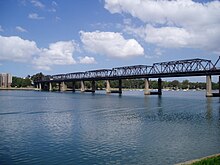Iron Cove Bridge
| Iron Cove Bridge | |
|---|---|
 |
|
| Carries | Motor vehicles, pedestrians and bicycles |
| Crosses | Iron Cove |
| Locale | Sydney, Australia () |
| Official name | Iron Cove Bridge |
| Maintained by | Roads and Maritime Services |
| Characteristics | |
| Design | Truss bridge |
| Total length | 468 m (1,535 ft) |
| Width | 13.5 m (44 ft) |
| Clearance below | 12 metres (39 ft) |
| History | |
| Opened | July 1955 |
| Iron Cove Bridge | |
|---|---|
 |
Iron Cove Bridge is a heritage listed bridge linking the suburbs of Drummoyne to Rozelle in New South Wales, Australia.
The original bridge was constructed of wrought iron lattice girders and opened in 1882 after four years of construction. The area was sparsely populated in the 1880s and the opening of the new bridge not only helped accessibility but also provided a new western route to Sydney via Balmain. The old spans were re-used by means of purchase by Gordon Duff and are still in use in the Forbes area. All that remains in place of the original bridge are the sandstone abutments situated on both sides of the cove about 20 metres (65 ft) south of the current bridge. The abutment on the Drummoyne side is listed on the NSW Heritage Register.
A decision to replace the original bridge was made in 1939 just prior to the outbreak of World War II. Design work began in 1942 and construction by Hornibrook McKenzie Clarke Pty Ltd commenced in 1947. The bridge was officially opened by Hon. J.J. Cahill, MLA, Premier and Colonial Treasurer of NSW on 30 July 1955.
The bridge was built to carry four lanes of traffic, but a fifth lane was later added to the southwest side of the bridge. This extra lane runs outside of the main bridge supports, forcing traffic to remain in the lane for the length of the bridge. The default configuration is three westbound and two eastbound lanes, switching to two westbound and three eastbound lanes during the morning peak. Because of their good resistance to corrosion, all nine of the 1882 bridge's 38.5-metre spans are in current use in three bridges on country roads near Forbes, New South Wales.
The bridge has aesthetically distinctive piers and abutments which reflect the Inter-War Art Deco style. Furthermore, it was the last steel truss bridge to be constructed in New South Wales in which rivets were used for field connections prior to the introduction of high strength bolts.
In April 2009, the NSW Government approved plans to construct a second bridge over Iron Cove as part of the Inner West Busway along Victoria Road. The new bridge was constructed on the western side of the existing bridge and holds three westbound traffic lanes with one lane designated as a morning peak bus lane. The existing bridge now carries three city bound traffic lanes and a 24-hour bus lane. The existing outrigger lane has been closed and is now only used for maintenance reasons. There is also a 4.3-metre (14 ft) wide pedestrian and cycle path on the western side of the new bridge which connects to both The Bay Run and Victoria Road. Work on the duplicate bridge commenced in July 2009. It was first opened to traffic late on Friday 28 January 2011.
...
Wikipedia

